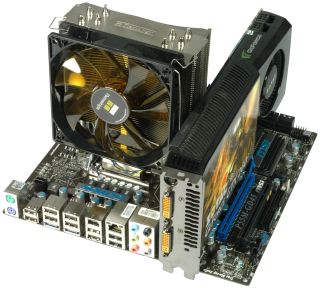Compact P55: Four MicroATX Motherboards Tried And Tested
MSI P55M-GD45

Board revision 1.0; BIOS 1.3

Our last motherboard is MSI’s P55M-GD45, one of five P55 boards in MSI’s lineup and the only one based on a microATX form factor. All capacitors on this motherboard are solid, as on the ASRock and Gigabyte boards. And as with Gigabyte, MSI equipped the P55M-GD45 with a number of its differentiating enthusiast-class features, including OC Genie for automated dynamic overclocking, DrMOS voltage regulators, and Active Phase Switching (APS) to increase power efficiency. We used the Green Power setting in the BIOS and set CPU Phase Control to Auto mode.
MSI also equips the board with two x16 PCI Express slots. The primary slot employs the processor’s 16 PCI Express 2.0 lanes, while the secondary slot is driven by four PCIe lanes off the P55 chip. The board supports both ATI CrossFire and Nvidia SLI, though again, we'd recommend against dropping a pair of powerful GPUs onto a platform limited to four PCIe lanes running at previous-gen speeds. A third x1 PCIe slot is available for add-on cards, plus there's one PCI slot.

Serial and parallel ports are available, but they require slot panel adapters if you decide to use them. MSI’s I/O panel is crammed with ten USB 2.0 ports, PS/2 mouse and keyboard connectors, a gigabit Ethernet port, two eSATA ports, and audio connectors. Unfortunately, digital outputs are missing entirely.


MSI’s positioning of the floppy and UltraATA connectors is exactly the opposite of Gigabyte’s board. The floppy connector is on the front, while the IDE port can be found on the board's bottom. All six SATA 3 Gb/s ports are bent by 90 degrees, allowing users to access them, even if long expansion cards are installed. This board also comes with a piezo PC speaker and a PCB-mounted power button. The P55M-GD45 showed the lowest average and total power consumption numbers in our efficiency test. Combined with the quickest runtime results, this board proved to be our efficiency winner.

Stay on the Cutting Edge
Join the experts who read Tom's Hardware for the inside track on enthusiast PC tech news — and have for over 25 years. We'll send breaking news and in-depth reviews of CPUs, GPUs, AI, maker hardware and more straight to your inbox.
Most Popular

